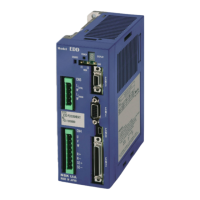11. Alarm and Warning
— 11-23 —
11.3.26. Warning P5: Main Power Under Voltage
The main power voltage must be in the specification to activate the Motor servo. The Driver Unit gives
this warning when the main power voltage is too low to activate the Motor servo.
Table 11-35: Cause and remedy for the warning P5
Commutation voltage falls below
+ 60 [V] (correspond to the input voltage
of 40 [VAC]) because the main power
supply voltage is lower than the
specification.
Confirm the voltage of main power supply and turn on the power again.
The input SVON is inputted before the
main power is turned on
Wait for 0.5 [s] or more after the main power is turned on and turn on the
input SVON.
Simultaneously input the input SVON
and the main power supply.
Defective Cable, Motor or Driver Unit
Check the Motor and the Cable referring to “Appendix 2: how to Check
Motor Condition” and replace them if necessary.
If the above measures do not work, the Driver Unit may be defective.
Replace it referring to “Appendix 5: Procedure for Replacing Driver Unit
Model EDD”.
(1) The input ACLR (Alarm clear) or the command CL (Clear alarm) after the cause of the warning is
removed.
11.3.27. Alarm P9: Power Module Alarm
The Driver Unit has the power module to flow the current through the Motor. The Driver Unit gives the
alarm when the power module generates heat abnormally or supplies excessive current to the Motor.
Table 11-36: Cause and Remedy for the alarm P9
The power module on the power
amplifier is overheated.
Review the rate of operating time and the idle time (Increase the idle time)
Decrease the moment of inertia.
Reduce acceleration and deceleration.
Review the environment for installing Driver Unit
Defective insulation of the Motor cable
Visually check the Motor cable for damage on the cable cover
Check the Motor and the Cable referring to “Appendix 2: how to Check
Motor Condition” and replace them if necessary.
Defective insulation of the Motor winding
Defective control power supply on the
power amplifier
If the above measures do not work, the Driver Unit may be defective.
Replace it referring to “Appendix 5: Procedure for Replacing Driver Unit
Model EDD”.
(1) Cool off the Driver Unit by air cooling when this alarm occurs.

